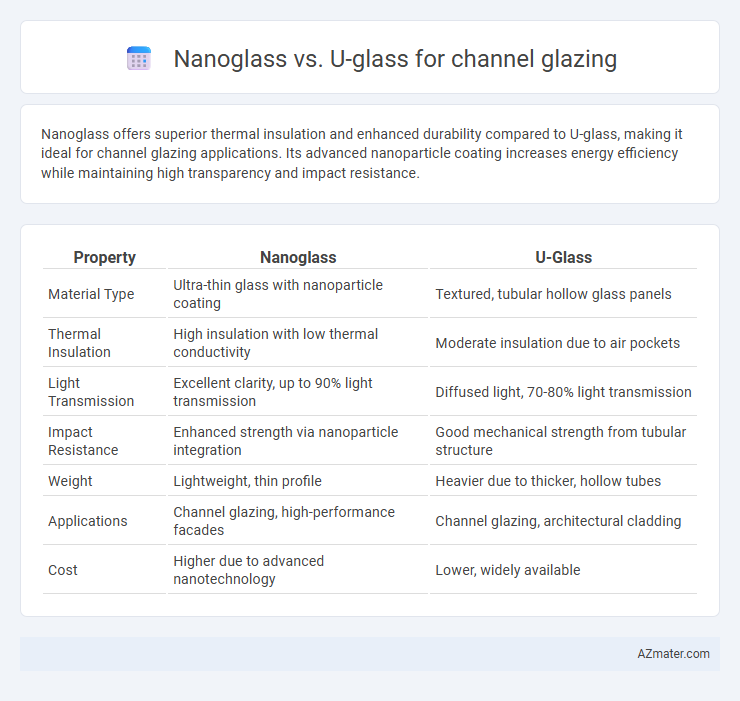Nanoglass offers superior thermal insulation and enhanced durability compared to U-glass, making it ideal for channel glazing applications. Its advanced nanoparticle coating increases energy efficiency while maintaining high transparency and impact resistance.
Table of Comparison
| Property | Nanoglass | U-Glass |
|---|---|---|
| Material Type | Ultra-thin glass with nanoparticle coating | Textured, tubular hollow glass panels |
| Thermal Insulation | High insulation with low thermal conductivity | Moderate insulation due to air pockets |
| Light Transmission | Excellent clarity, up to 90% light transmission | Diffused light, 70-80% light transmission |
| Impact Resistance | Enhanced strength via nanoparticle integration | Good mechanical strength from tubular structure |
| Weight | Lightweight, thin profile | Heavier due to thicker, hollow tubes |
| Applications | Channel glazing, high-performance facades | Channel glazing, architectural cladding |
| Cost | Higher due to advanced nanotechnology | Lower, widely available |
Introduction to Channel Glazing Systems
Channel glazing systems utilize glass panels securely fitted into U-shaped aluminum or steel channels, offering sleek aesthetics and enhanced weather resistance for facades. Nanoglass, with its advanced micro-structured surface, provides superior strength and self-cleaning properties compared to traditional U-glass, improving durability and maintenance efficiency in channel glazing applications. The integration of Nanoglass in channel glazing optimizes thermal performance and light transmission, making it an innovative choice for modern architectural designs.
What is Nanoglass?
Nanoglass is an advanced glazing technology featuring a thin, transparent coating that enhances thermal insulation and solar control properties, making it ideal for channel glazing applications in facades. Its nanostructured surface reduces heat transfer and improves energy efficiency compared to conventional U-glass, which is a double-layered glass with an air gap providing basic insulation. Nanoglass significantly lowers U-values and enhances daylight transmission without compromising strength, outperforming traditional U-glass in energy-saving performance.
What is U-glass?
U-glass, also known as channel glass, is a type of structural glazing made from hollow U-shaped glass channels that interlock to form continuous facades or partitions with minimal framing. It offers excellent natural light diffusion, thermal insulation, and soundproofing while maintaining high strength and durability. Compared to Nanoglass, U-glass provides a distinct architectural aesthetic ideal for large openings and modular designs but may have limitations in customization and advanced coating technologies.
Nanoglass vs U-glass: Material Composition
Nanoglass for channel glazing is composed of ultra-thin, high-purity glass layers combined with advanced polymer interlayers, providing superior clarity and enhanced thermal insulation. U-glass, or U-shaped glass channels, typically consist of thick, textured soda-lime glass designed for durability and structural support rather than optical performance. The material composition of Nanoglass offers improved strength-to-weight ratio and better energy efficiency compared to the heavier and less transparent traditional U-glass.
Thermal Performance Comparison
Nanoglass offers superior thermal performance for channel glazing compared to U-glass, featuring lower thermal conductivity and higher insulating values that reduce heat transfer and enhance energy efficiency. U-glass, while durable and cost-effective, typically exhibits higher U-values, resulting in greater heat loss and less effective thermal insulation. For applications prioritizing energy conservation and reduced heating or cooling loads, Nanoglass provides a more advanced solution in terms of thermal resistance and overall performance.
Strength and Durability Factors
Nanoglass demonstrates superior strength and durability compared to U-glass for channel glazing applications, featuring enhanced resistance to impact and environmental stress due to its advanced nanotechnology composition. U-glass, while offering good structural integrity, typically falls short in long-term performance under harsh weather conditions and mechanical wear. The nanostructured surface of Nanoglass also provides improved resistance to scratches and chemical degradation, extending the service life of channel glazing installations significantly.
Aesthetic and Design Flexibility
Nanoglass offers superior aesthetics with its ultra-clear transparency and smooth surface, enhancing the visual appeal of channel glazing by providing a sleek, modern finish. U-glass, characterized by its characteristic ridged pattern and translucency, delivers a diffused light effect that complements architectural designs seeking a blend of privacy and illumination. The design flexibility of nanoglass allows for seamless integration into contemporary structures with customizable sizes and shapes, while U-glass is often favored for its modular and consistent panel system suitable for repetitive patterns.
Installation and Maintenance Differences
Nanoglass offers a lightweight, easy-to-handle solution for channel glazing that simplifies installation, featuring interlocking panels requiring fewer fasteners compared to the U-glass system. U-glass typically demands more precise alignment and heavier support structures, increasing installation time and labor costs. Maintenance on Nanoglass is minimal due to its durable, scratch-resistant surface that resists staining, while U-glass may require frequent cleaning and occasional sealing to maintain its clarity and integrity.
Cost Analysis: Nanoglass vs U-glass
Nanoglass generally offers higher initial costs compared to U-glass due to advanced manufacturing and energy-efficient properties. U-glass tends to be more affordable upfront but may incur higher long-term expenses owing to lower insulation performance and potential maintenance. Evaluating cost analysis for channel glazing should consider lifecycle expenses, including installation, energy savings, durability, and replacement frequency.
Choosing the Best Glass for Channel Glazing
Nanoglass offers superior thermal insulation and enhanced durability compared to traditional U-glass, making it ideal for energy-efficient channel glazing applications. The advanced nanocoatings on Nanoglass improve light transmission and reduce glare, optimizing daylighting performance in architectural facades. U-glass remains a cost-effective choice for budget-conscious projects but falls short in thermal performance and longevity relative to Nanoglass.

Infographic: Nanoglass vs U-glass for Channel glazing
 azmater.com
azmater.com